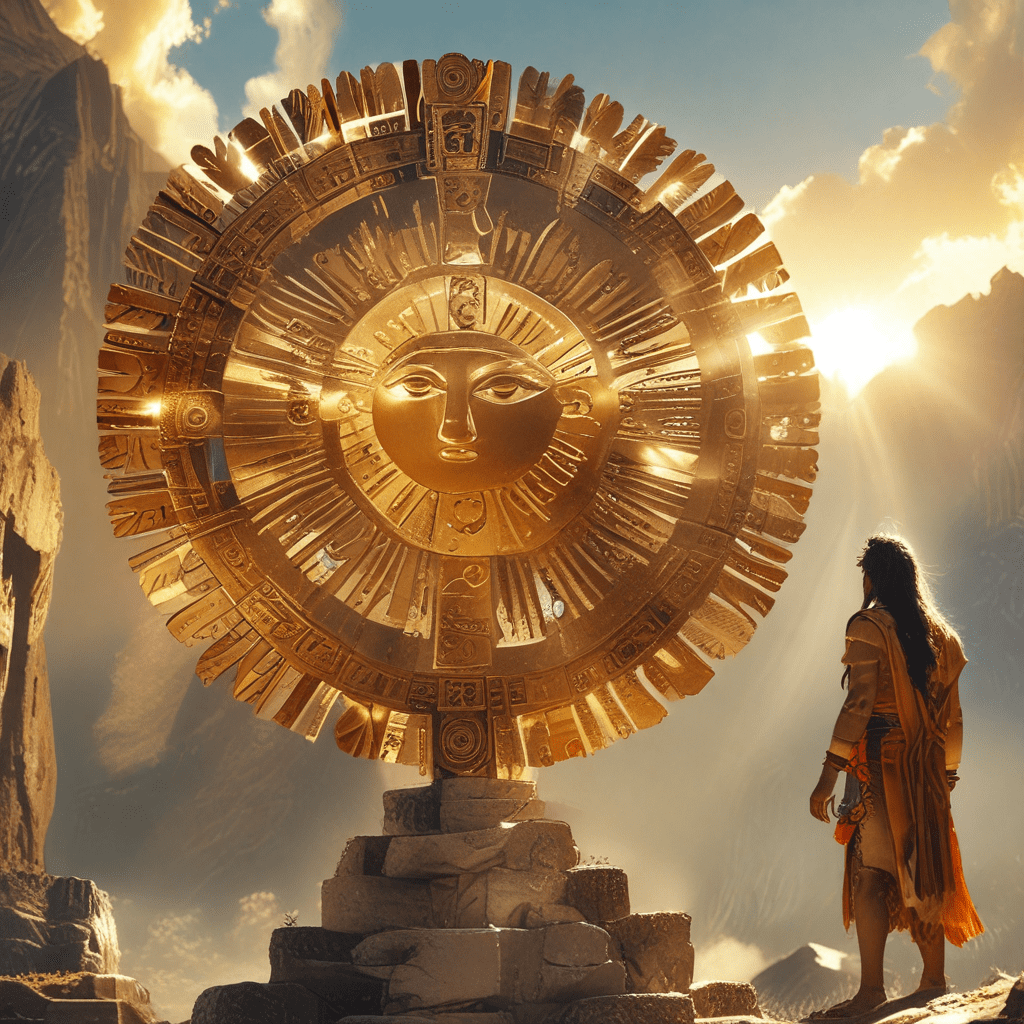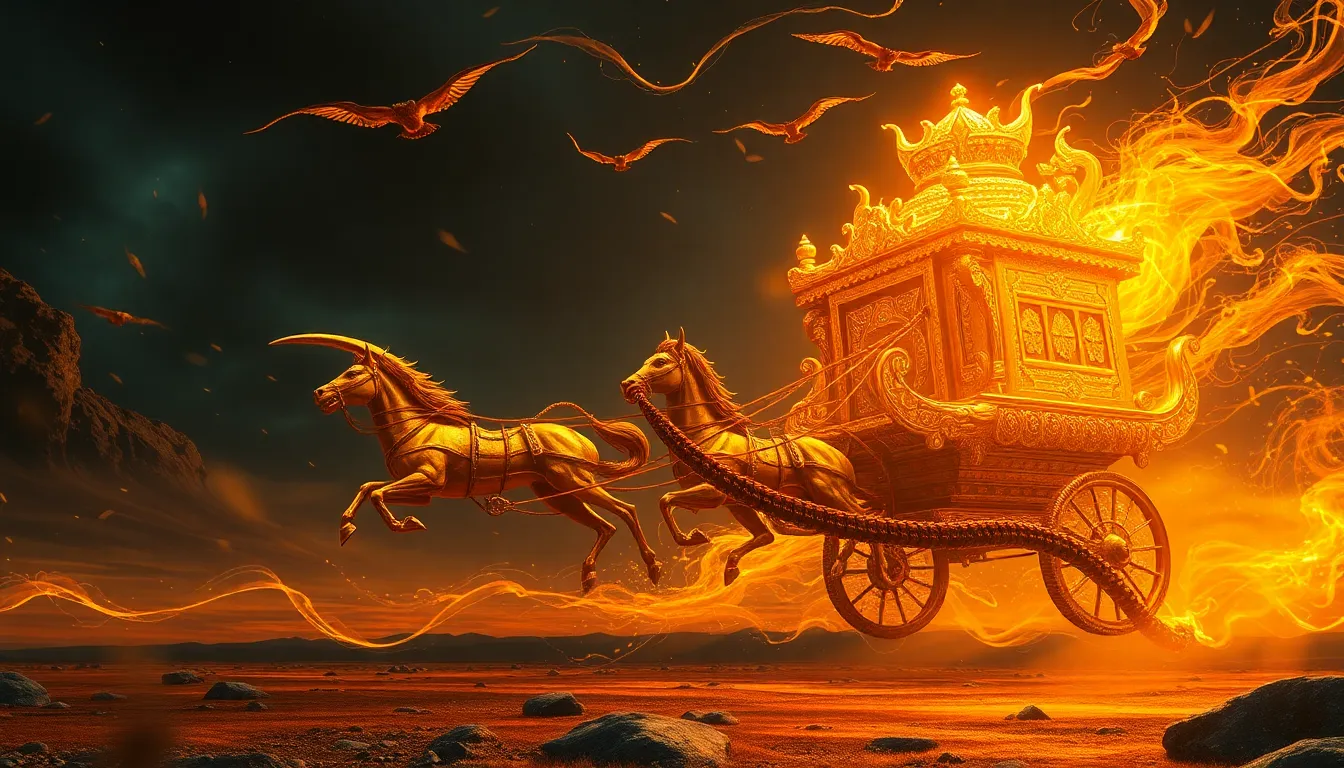The Incan Myth of the Golden Sun Disk: A Symbol of Divine Power
In the ancient Andean world, the Inca civilization flourished, leaving behind a rich tapestry of myths, legends, and religious beliefs. At the heart of their spiritual world stood Inti, the Sun God, whose celestial power and influence shaped their understanding of the universe and their place within it. Incan mythology is replete with stories that highlight the profound reverence they held for Inti, the life-giving force that sustained their world. One such symbol of Inti's power is the legendary Golden Sun Disk, a sacred artifact that held immense spiritual and political significance for the Inca empire.
The Incan Pantheon: Inti, the Sun God
In the Incan pantheon, Inti reigned supreme as the most important deity. He was revered as the creator of the world, the source of life, and the giver of warmth and light. Inti was believed to be responsible for the seasons, the growth of crops, and even the health and well-being of the Inca people. He was often depicted as a young, handsome man adorned with a golden headdress and a golden disk representing the sun. His power was absolute, and his wrath was feared. Incan rituals and ceremonies were meticulously designed to appease Inti and ensure his continued favor, demonstrating the profound influence he held over their lives.
The Golden Sun Disk: A Sacred Artifact
The Golden Sun Disk, a symbol of Inti's divine power, played a central role in Incan mythology and religion. It was believed to be a physical representation of the sun god, embodying his light, warmth, and life-giving energy. Made of pure gold, the disk was highly ornate, often adorned with intricate designs and precious stones. The Golden Sun Disk was not simply a decorative object but held immense spiritual significance. It served as a bridge between the human world and the divine realm, a tangible link to Inti's presence. The disk was not worshipped directly, but rather served as a focal point for rituals and prayers directed towards the Sun God.
The Creation Myth: Inti and the Birth of the World
Incan mythology tells a fascinating story about the creation of the world and the role of Inti in bringing life to the universe. According to their beliefs, Inti, along with his sister Mama Killa, the Moon Goddess, were the offspring of Viracocha, the supreme creator deity. Inti, filled with divine power, emerged from a cave in the Andes Mountains and brought light and warmth to a previously dark and barren world. The creation myth highlights the central role of Inti in bringing life to the universe and establishing order in the cosmos, further solidifying his position as the most powerful deity in the Incan pantheon.
Power and Authority: The Sun Disk as a Symbol of Incan Rule
The Golden Sun Disk was not only a symbol of Inti's divine power, but it also served as a powerful symbol of the Inca emperor's authority. The Inca emperor was seen as Inti's representative on earth, a divinely appointed ruler who wielded absolute power over his people. He was believed to have been chosen by Inti to maintain order and prosperity within the empire. The Golden Sun Disk, held in the Temple of the Sun, served as a constant reminder of the emperor's divine mandate and the importance of obedience to his rule. The disk's presence in royal ceremonies and its display in the Temple of the Sun solidified the link between the Inca emperor and the divine, legitimizing his rule and reinforcing his position as the supreme authority within the Inca empire.
The Role of the Inca Emperor: A Divine Representative
The Inca emperor, known as the Sapa Inca, held a unique and powerful position within the empire. He was not simply a king, but a divine ruler, considered to be Inti's representative on earth. This connection to the Sun God imbued him with immense power and authority. He was believed to have been chosen by Inti to lead and protect his people. The emperor was responsible for maintaining order, ensuring prosperity, and upholding the traditions and beliefs of the Inca civilization.
The emperor's connection to Inti was evident in his attire and ceremony. He wore elaborate clothing adorned with gold and feathers, symbolizing his divine status. He participated in elaborate rituals and sacrifices to honor Inti, seeking his favor and blessings for the empire. The Golden Sun Disk, kept within the Temple of the Sun, served as a constant reminder of the emperor's divine mandate and the sacred nature of his rule.
The Temple of the Sun: A Place of Worship and Ritual
The Temple of the Sun, located in the heart of Cusco, the Incan capital, was a magnificent structure dedicated to Inti. It was considered a sacred place, a link to the divine realm, and a focal point for worship and rituals. The Golden Sun Disk was kept inside the temple, housed within a special chamber, and was the centerpiece of religious ceremonies. Only the highest priests and the emperor could enter this chamber, demonstrating the sacred nature of the artifact.
The temple was adorned with gold, silver, and precious stones, further emphasizing its importance and sanctity. Priests would gather here to perform elaborate rituals, offering sacrifices, prayers, and hymns to Inti. The Temple of the Sun was not only a place of religious devotion but also a symbol of Incan power and authority, representing the strong connection between the emperor, the people, and the divine realm.
The Sun Disk in Ceremonial Practices
The Golden Sun Disk played a central role in numerous Incan ceremonies and rituals, These events were held throughout the year, each with its own purpose and significance. The Inca people believed that by honoring Inti through these ceremonies, they could secure his favor and ensure a prosperous harvest, good health, and protection from harm.
One of the most important ceremonies was the Inti Raymi, the annual festival of the Sun God. This grand celebration took place during the winter solstice, marking the return of the sun and the beginning of the growing season. During this festival, the emperor would lead a procession to the Temple of the Sun, accompanied by priests, nobles, and commoners. The Golden Sun Disk would be brought out of its chamber and displayed prominently, serving as a focal point for worship and prayers.
Theories on the Sun Disk’s Origins and Purpose
The exact origins and purpose of the Golden Sun Disk remain a mystery. Archaeologists and historians have proposed several theories about its creation and usage:
A Symbol of Inti's Divine Power: The most widely accepted theory suggests that the disk was a physical representation of Inti, embodying his light, warmth, and life-giving energy. It was likely created as a focal point for worship and prayer, serving as a tangible link to the Sun God.
A Symbol of Royal Authority: The Golden Sun Disk might also have been a symbol of the Inca emperor's authority. Its presence in the Temple of the Sun and in royal ceremonies reinforced the link between the emperor and the divine, legitimizing his rule and emphasizing his divinely appointed status.
A Ritualistic Object: Some scholars believe that the disk had a more practical purpose in ritualistic practices. It might have been used to focus sunlight for specific ceremonies or to reflect the sun's rays during religious observances.
- A Treasure of the Inca Empire: The Golden Sun Disk was undoubtedly a valuable and treasured artifact, reflecting the wealth and craftsmanship of the Inca civilization. Its use might have been primarily decorative and symbolic, but it undoubtedly held immense cultural and religious significance for the Inca people.
The Legacy of the Golden Sun Disk: Enduring Symbolism
The Golden Sun Disk, despite its mysterious origins and its eventual disappearance after the Spanish conquest, continues to hold a significant place in the history of the Inca civilization. It remains a powerful symbol of their religious beliefs, their reverence for the sun, and the profound influence of Inti in their lives. The disk's image and the stories surrounding it continue to inspire awe and wonder, reminding us of the rich cultural heritage of the Inca people and their intricate connection with the natural world.
FAQ
1. What is the Golden Sun Disk?
The Golden Sun Disk is a legendary artifact of the Inca civilization, believed to be a physical representation of Inti, the Sun God. Made of pure gold, it was highly ornate and served as a focal point for worship and rituals.
2. Why was the Golden Sun Disk Important to the Inca?
The Golden Sun Disk held immense spiritual and political significance for the Inca. It embodied Inti's divine power, symbolized the emperor's authority, and served as a link between the human world and the divine realm.
3. What happened to the Golden Sun Disk?
The Golden Sun Disk was lost after the Spanish conquest of the Inca Empire. Its fate remains unknown, and its disappearance is a source of ongoing mystery and speculation.
4. What is the significance of the Golden Sun Disk today?
The Golden Sun Disk continues to hold a significant place in the history of the Inca civilization. It remains a powerful symbol of their religious beliefs, their reverence for the sun, and the enduring influence of their culture.



